Two-Ten-Jack is
one of the lesser known Japanese card games. The game is a trick taking type game for two players and the name of the game is derived from the primary point scoring cards featured in the game.
The game uses one standard 52 card deck with the ranking of the cards in that deck as follows (from highest to lowest); Ace, King, Queen, Jack, 10, 9, 8, 7, 6, 5, 4, 3, 2.
Determination of first dealer can be performed in a variety of ways, with a round of Janken a commonly used method,
with the winner of the throw set as the first dealer. After each hand, the role of dealer alternates amongst the two players.
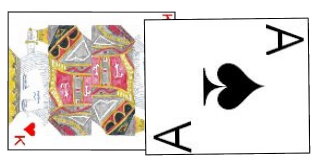
In Two-Ten-Jack, the suit of Hearts (
♥) is always considered the permanent trump suit for the hand. In addition, the Ace of Spades (♠) is a special card (called the Speculation), which is considered the highest card in the deck. However, this card does have some specific rules on when it can be played
(see further below).
To begin, the designated dealer thoroughly shuffles the deck and offers the deck to his opponent to cut. After the cut, the dealer then begins dealing the cards, one-by-one and face down, starting with his opponent. He continues dealing until both his opponent and himself have six total cards. He then places the remainder of the deck face-down in the center of the table as the stock.
The opponent of the current dealer leads the first card to the first trick. In leading to a trick a player may select any card in his hand to lead to that trick. After the lead the opposing player then plays one card from his own hand to the same trick. In playing a card to a trick led by the opponent, a player must play a card of the same suit as originally led to the trick if he has such a card. If the player does not have such a card he must play a card of the Trump suit to the trick if he has one. If he also does not have a card of the trump suit he may play any card from his hand. The highest card of the trump suit played to the trick wins the trick if the trick contains a card of the trump suit. If the trick contains no cards of the trump suit, the highest card of the suit originally led to the trick wins it. The winner of each trick should take the cards from the trick and set them aside in a face-down pile for scoring at the end of the hand. The winner of each trick then takes the top card from the stock adding it to his hand and his opponent then takes the next card from the stock adding it to his own hand. The winner of each trick leads the first card to the next trick.
As mentioned previously, the Speculation (Ace of Spades) is a special card which is considered the highest card in the deck and will win any trick it is legally played to. However, there are a few special rules regarding it's play:
- Speculation can be led to any trick. If so led to a trick, the player of the card must also state either Spades or Hearts, indicating the suit that the card is representing to which the opposing player must play a card of that suit if he has one. Speculation always wins the trick.
- If a card of the Trump suit (Hearts) is led to a trick, a player who holds the Speculation may play this card to the trick or another card of the trump suit. If the player has no cards in the suit of Hearts but does have the Speculation, he must play that card. The Speculation always wins the trick.
- If a card in the suit of Spades is led to the trick, a player who holds the Speculation may play any card in the suit of Spades to the trick if he has one. However, if has only the Speculation he must play that card to the trick, which always wins the trick.
- If a card in the suit of Diamonds or Clubs is led to the trick, a player with the Speculation in hand must play a card in the suit led to the trick if he has one. If he does not have such a card, he must play a card in the Trump suit to the trick or the Speculation, if he has no other cards in the trump suit he must play the Speculation. The Speculation always wins the trick.
The game continues in this way with each player playing a card to successive tricks and then the players each drawing a card in order until the stock has become exhausted, containing no more cards. The players then continue the game playing with the just the cards remaining in the hand. Once the stock is
exhausted and the players have each played the last card from the hand, scoring for the hand occurs. Scoring consists of the players each examining his pile of cards won in tricks during the hand. Certain cards won during the hand have a positive or negative point value which the player will add to his cumulative score, as follows:
| Card | Point Value |
|---|
| 2 Of Hearts (♥), 10 of Hearts (♥), Jack of Hearts (♥) | 5 Points each |
| 2 Of Spades (♠), 6 of Diamonds (♦), 10 of Spades (♠), Jack of Spades (♠), Ace of Spades (♠) | 1 Point each |
| 2 Of Clubs (♣), 10 of Clubs (♣), Jack of Clubs (♣) | -5 Points each |
| All Other Cards | 0 Points |
|
|
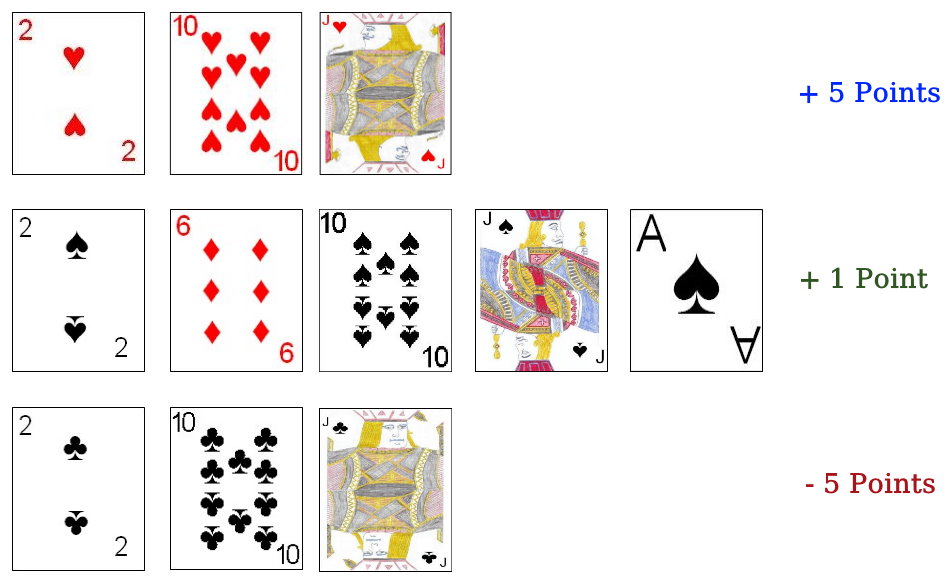 |
The players thus add (or subtract) the total number of points earned during the hand to his ongoing, cumulative score. If, after all points are calculated at the end of a hand, one or both players manage to score 31 or more
total cumulative points, the player with the highest total score is declared the overall game winner.
Kaali Teeri: Kaali Teeri is a game from India
which resembles other games found on this page due to the players goal
to attempt to capture certain cards in the deck to obtain the highest
score. The game is designed for four players, although a six player variant is described further below. This game is also known, in English, as Three of Spades, which is a direct translation of the card game's name in Hindi.
Kaali Teeri is played using one standard 52 card deck. The ranking of the cards
used for this game is fairly standard, however, the Three of Spades is considered a permanent member of the trump suit, and is actually the highest card in the trump suit. Thus, in the designated trump suit, the ranking of the cards is as follows: Three of Spades (♠), Ace of trump Suit, King of trump suit, Queen of trump suit, Jack of trump suit, 10 of trump suit, 9 of trump suit, 8 of trump suit, 7 of trump suit, 6 of trump suit, 5 of trump suit, 4 of trump suit, 3 of trump suit (unless Spades is the trump suit in which case this card is the highest ranked card), 2 of trump suit. In the non-trump suits, the ranking of the cards in each suit is as follows: Ace, King, Queen, Jack, 10, 9, 8, 7, 6, 5, 4, 3 (except in Spades in which the 3 of Spades is considered a member of the trump suit), 2. It should be thusly noted that the three of Spades is promoted to the top ranking card in the trump suit. This card is thus considered a permanent member of the trump suit and should be played at any time a card of the trump suit should or must be played.
Determination of the first dealer and seating positions can be performed using a variety of methods, with draw for high card a common method. Using this method, each player would draw a card from the shuffled, face-down deck (with any players drawing cards of the same rank re-drawing). The players would then take seats at the table in order of rank of cards drawn, from highest to lowest. The player drawing the highest card of all is set as the first dealer. Thereafter, the role of dealer rotates in a clockwise direction around the table.
Once the initial dealer has been determined, this player should thoroughly shuffle the deck and offer it to the player at his immediate left for the cut. After the cut, the dealer then begins distributing the cards in a clockwise direction around the table, starting with the player at his immediate left. The cards are dealt individually and face-down in front of each player. The dealer continues dealing until the entire deck has been dealt out to the players.
After the cards have been dealt, the players then pick up the cards
and examine the hand. A round of bidding then begins, starting with the
player at the immediate left of the dealer and rotating around the table
in a clockwise direction from player to player. A bid is that player's
declaration of a number of points he is contracting to win during the hand. The minimum bid is usually set at 150 and the maximum bid would be 250. These points are based on card values as these cards are won in tricks (see the chart further below which shows the value of each card in the deck). In order to be a valid bid, a bid must be of a higher value than any previous bid. If a player does not prefer to bid he can also elect to pass. The bidding continues until a bid is followed by three consecutive passes, after which the last player to bid becomes the highest bidder.
This player then announces his selection of the suit to be set as the trump suit (this trump suit is called "Sir"). In addition, he then names any card he does not have in his hand. Whichever other player has that card is then set as the secret partner to this player. However, this player does not state this fact so it is initially unknown who the secret partner of the high bidder is. The goal of the high bidder and his unknown partner is to score at least as many card points as his high bid. This is done by capturing point scoring cards in tricks.
Once the trump suit has been declared, play of the hand begins, through a series of tricks. The high bidder plays the first card to the first trick with each other player in a clockwise direction then playing one card from the hand to that same trick.
In leading to a trick, a player may play any card still remaining in his
hand to start the trick. Each other player then plays a card of the same
suit as originally led to the trick if he has one. If he has no such
card, he may play any card from his hand, including a card of the trump
suit. After each player has played a card to the trick, it is then
determine which player has won the trick. The highest card in the trump
suit played to the trick wins the trick. If the trick contains no cards of the trump suit, the trick is won by the highest card of the suit originally led to the trick. The cards won in tricks should be gathered and placed in a face-down pile next to the player who has so won that trick. The winner of each trick leads the first card to the next trick.
After all the tricks have been played and won, all cards won by the high bidder and his partner are reviewed to determine if they have earned at least as many points as the high bidder bid. The following chart shows the values of each card in the deck:
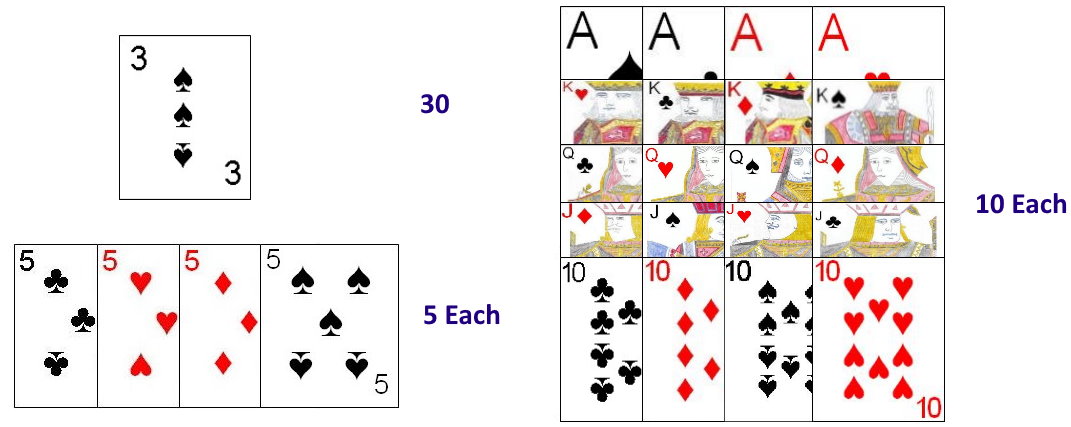 |
|
| Card | Point Value |
|---|
| Three of Spades (♠) | 30 |
| Ace, King, Queen, Jack, 10 | 10 Each |
| Five | 5 Each |
| 9, 8, 7, 6, 5, 4, 3 of Clubs (♣), 3 of Diamonds (♦), 3 of Hearts (♥), 2 | 0 |
|
If the high bidder and his partner for the hand manage to score at least as many points as bid, both players in that partner score the amount of the bid. However, if they do not manage to capture at least as many points as bid, they score 0 and the opponents score the amount of the bid.
After a set number of hands (which should be an even multiple of 4) the player with the highest grand total is declared the winner of the game.
Kaali Teeri for Five and Six Players: Kaali Teeri can also be played by five or six participants, with the following modifications to the rules.
- In order to ensure that each player receives the same number of cards,
certain cards are removed to allow the cards to be dealt evenly. For five
players, two cards of rank two are removed and for the six player variant all four cards
of rank 2 are removed from the deck, making a 48 card deck used for that version of the game. Thus, in the five player variant each player will receive ten cards and for the six player variant each player will receive 8 total cards in the deal.
- If the highest bid is the maximum bid (exactly 250) the high bidder may then call for two partner cards instead of just one, with the holders of those cards set as the hidden partners for the high bidder. If the same player has both of the cards called, the high bidder will end up having only one hidden partner.
In all other aspects the versions for additional players are played the same as the standard version of the game.
Etori: Etori is an old Japanese card game which was popular in the late 1800's and very early 1900's. Etori is not known to have any current players, although a newer variant of the game, Kakeya Toranpu, is still played in one small area of Japan. The rules for that game will be described further below.
The game is designed for play by four players. The players are formed into partnerships of two players each. Determination of these partnerships and the first dealer can be performed in a variety of methods, with draw for high cards a common method. Using this method, each player would draw a card from the shuffled deck. The players drawing the two highest cards would form one partnership and the two players drawing the two lowest cards would form the opposing partnership. The player drawing the highest card of all would have the first choice of seats at the table and is also set as the first dealer. Each player should be seated at the table in such a manner as to be directly across the table from his partner.
Etori uses one standard 52 card deck. The ranking of the cards in this deck are as follows, from high to low: Ace, King, Queen, Jack, 10, ,9, 8, 7, 6, 5, 4, 3, 2. The Ace of Spades (♠), however is a special card, called the Speculation (or Supekyureishon), to be described later.
Once the players are seated, the dealer thoroughly shuffles the cards and offers it to the player at his immediate left to cut. After the cut the dealer then begins dealing the cards to the players, one by one and face-down in a counter-clockwise direction around the table, starting with the player at his immediate right. He continues dealing in this rotation until the entire deck has been dealt.
For each hand a specific suit is set as the trump suit, in a rotating order. On the first hand, the suit of Hearts is set as the trump suit, for the second hand the suit of Diamonds is set as the trump suit and for the third hand the suit of Clubs is set as the trump suit. This rotation continues for the entire game, in this ongoing and repeating cycle. It should be noted that the suit of Spades is never set as the trump suit on any hand during
the game.
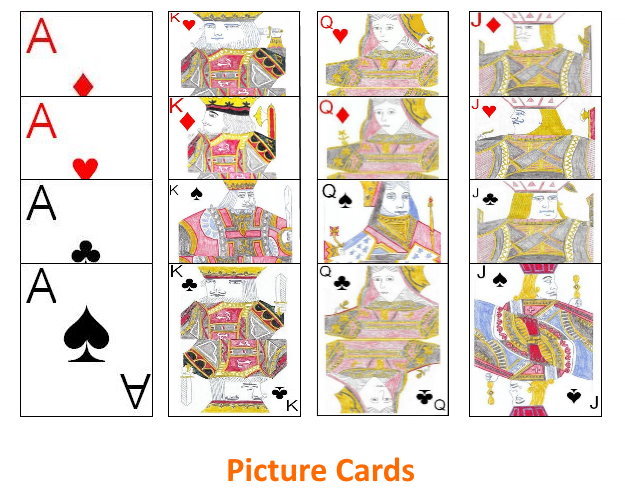
Either one of the players comprising the opposing partnership containing the dealer may lead the first card to the first trick. These players may discuss this issue but must not, under any circumstances reveal any specifics of the cards in hand, but rather just make statements such as indicating that they prefer to lead to this first trick or not. Once it is decided amongst these players who will lead, that player then leads the first card to the first trick to start play.
The leader to a trick may lead any card of his choice from his hand to start a trick. Each other player, in a counter-clockwise direction around the table then contributes one card to the same trick. If the player has a card of the same suit as led he must play it. However, if he has no cards of the suit originally led to the trick he may play any card from his hand including a card of the trump suit. The trick is won by the highest card of the trump suit played to it, or, if the trick contains no cards of the trump suit, by the highest card of the suit originally led to that trick. All cards won in tricks should be set aside face-down, near one of the players forming the partnership that won the trick. The winner of each trick leads the first card to the next trick.
As mentioned previously, the Ace of Spades, the Speculation, is a special card. This card will win any trick to which it is legally played, including a trick which may contain one or more cards of the trump suit. Although this card will win any trick, it is considered a member of the suit of Spades and thus would follow suit as a Spade if necessary.
After all tricks have been played and won, the cards won in tricks are examined to determine the winners of the hand and scoring. Each partnership counts the number of cards of rank Ace, King, Queen and Jack won in tricks during the hand. These scoring cards are called picture cards. If both teams capture exactly eight picture cards during the hand, there is no winner and no score for that hand. If one team manages to win nine or more such picture cards during the hand, that team earns one point. The game continues until one partnership reaches a pre-determined threshold of total points (such as 5) after which that team is declared the overall game winner.
Kakeya Toranpu: Kakeya Toranpu is a variant of Etori which is still currently played, but only in one small town, Kakeya Town, which is part of the city of Unnan in the Shimane Prefecture in Japan. The game is very similar to the game from which it was derived from, however it has several specific distinctions that make it a uniquely different game
although this variant is sometimes also called Etori.
Similar to Etori, Kakaya Toranpu is usually played by 4 players in two partnerships, however a variant which can be played by six participants is also described below. The game uses one standard 52 card deck with the usual ranking of cards in this deck as follows (from high to low): Ace, King, Queen, Jack, 10, 9, 8, 7, 6, 5, 4, 3, 2. The Ace of Spades (or sometimes the Ace of Clubs) is a special card, called Rensho, with special properties which will be described later.
Determination of partners in this game is very unique. Four sticks are used each with a number from 1 to 4 printed on the stick. Each player randomly draws one such stick. The players drawing the numbered sticks 1 and 3 play as partners against the players drawing the sticks numbered 2 and 4. The player drawing the stick numbered one has his choice of seats at the table. The player drawing the stick numbered two should sit to his right, his partner (having drawn the stick numbered 3) sits directly across from him and the player drawing the stick numbered 4 takes the last seat, across from his partner
(player 2). Dealing of each hand in Kakeya Toranpu is done by two dealers, which are the members of one of the partnerships. In the first hand, the dealers are the players who had drawn the sticks numbered 2 and 4. After each hand, the losing partnership deals the cards in the next hand.
At the start of the game, each partnership is provided 5 tokens or
stones from the Japanese game Go, which are used in keeping score during the game.
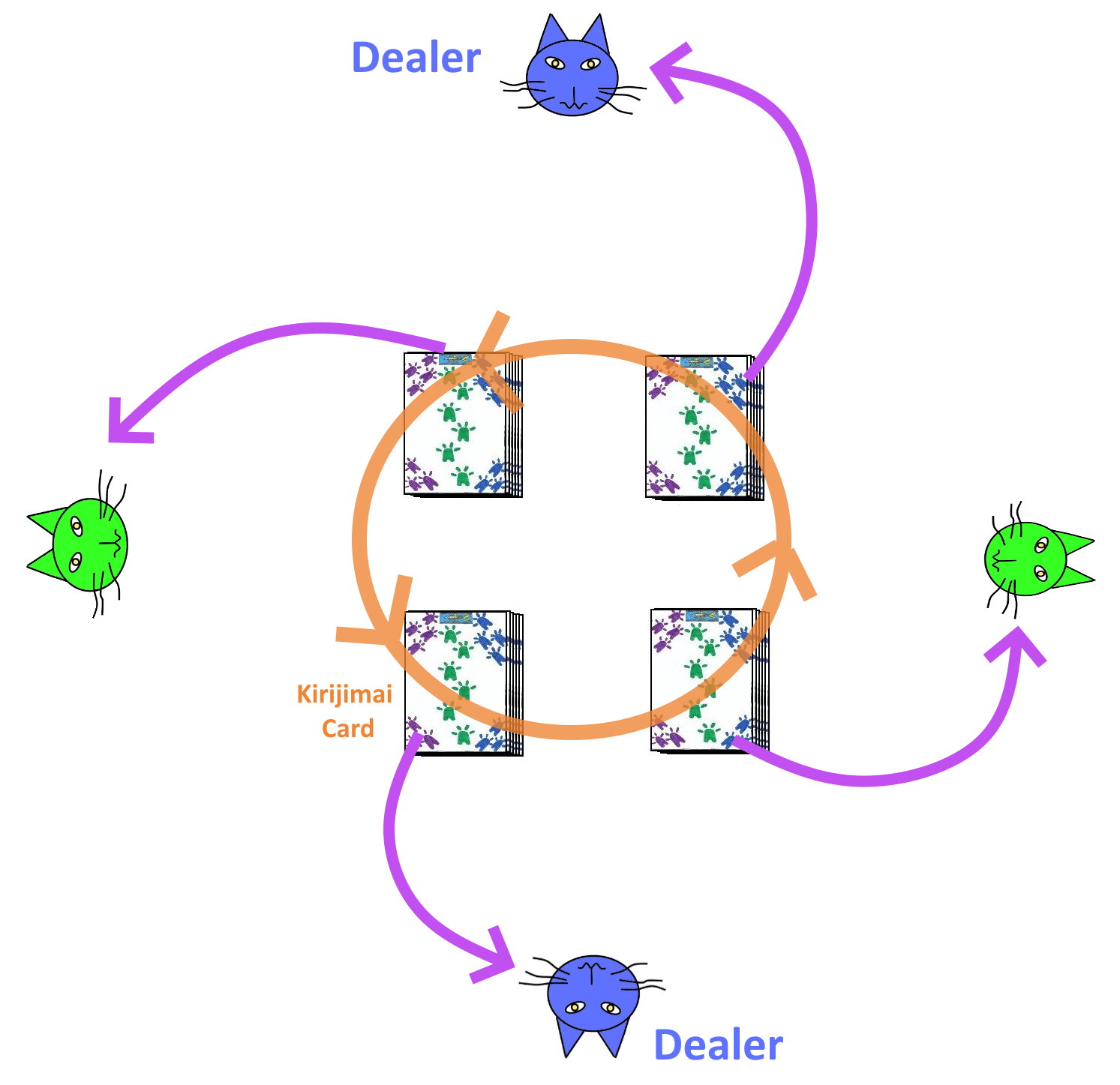
Both of the dealers for each hand would take approximately half of the deck and shuffle it thoroughly. One of the two dealers then begins dealing the cards, one-by-one and face-down into four distinct piles, formed in a square, in the middle of the table. He deals to these piles in a counter-clockwise direction, continuing until he runs out of cards in his stack. This first dealer then indicates the pile which should receive the next card and his partner then starts dealing from his own pile in the same way, starting with the pile indicated by his partner. He continues dealing also until his stack has also been exhausted. The last card dealt is called the Kirijimai. The pile containing this last card dealt is then taken by the player nearest to that pile who is one of the dealers on the current hand. After this player has taken his pile, the next player at his right takes the next pile
to the right of that the last pile and continuing to each subsequent
player in a counter-clockwise direction taking the next pile to the right of the last pile taken. Thus, each player will have taken one of the piles which becomes his hand.
Each hand will have a specific trump suit (or Kiri) designated for that hand. For the first hand, Spades is automatically set as the trump suit. However,
for each subsequent hand after the first, either member of the dealing team may, before any player has picked up his cards during this round, declare a change in the trump suit. The newly selected trump suit then becomes the trump suit for this hand and any subsequent hands unless a player on another round declares a new trump suit
at the start of another hand. It must be noted that a declaration for a new trump suit is done before any player has seen any cards in the hand. Once one or more players has picked up his hand
or seen any of the cards, the trump suit cannot be changed for that hand.
Either of the players comprising the opposing partnership to the dealers partnership may lead the first card to the first trick. The players may discuss this at the table but may only do so in general terms, stating whether they prefer to lead or not to that first trick.
The leader to a trick may lead any card of choice still remaining in his hand. Each other player, in a counter-clockwise direction must play one card from his hand to that same trick. If he has a card of the suit originally led to the trick he must play it. If a player has no cards of the suit originally led to the trick he may play any card from his hand, including one from the trump suit, if he has one. After all players have played one card to the trick, it is determined who won that trick. If the Rensho has been played to the trick, that card automatically wins the trick. If the Rensho has not been played to that trick, the trick is won by the highest trump card played to it. If the trick contains no cards of the trump suit and does not contain the Rensho, the trick is won by the highest card of the suit originally led to that trick. The leader of each trick leads the first card to the next trick.
As mentioned previously, the Rensho is a special card. Normally, the Ace of Spades is the Rensho. However, if Spades is the current trump suit the Rensho is the Ace of Clubs. The Rensho is considered a member of the suit of which it normally belongs (Spades or Clubs) and is thus played as such a card, however, the Rensho always wins a trick to which it is legally played.
The goal of the game is to capture the most picture cards (cards of denomination Ace, King, Queen and Jack), thus, all picture cards (also called Egara cards) captured in tricks are collected by one member of that partnership in a face-up pile. All other played cards are placed in a face-down pile near the center of the table.
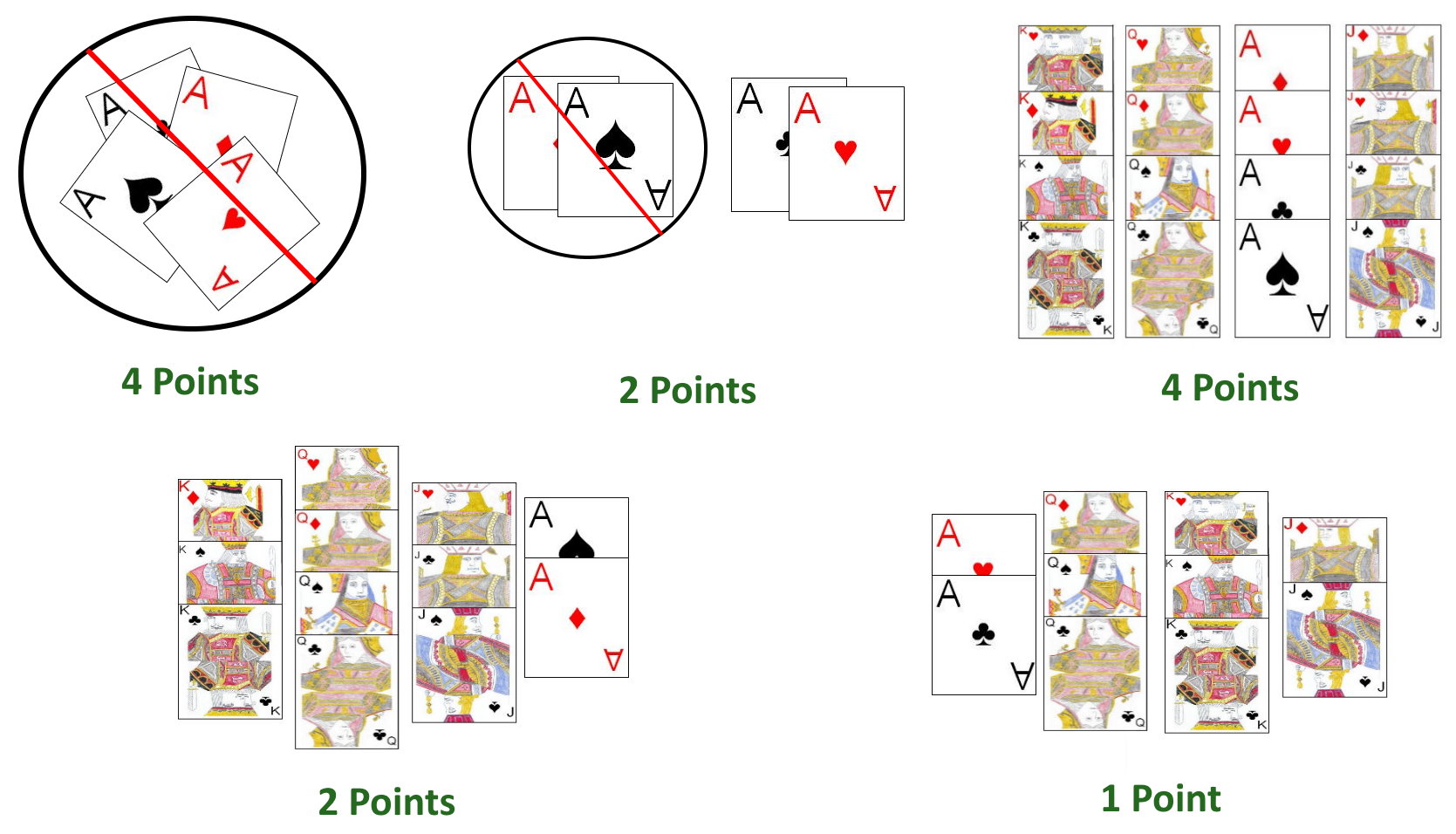
If either partnership manages to capture 9 or more picture cards during the hand, that team is considered the winner of the hand. If both teams capture exactly 8 picture cards during the hand, the opponents of the team who had played the Rensho are considered the winners. The winning team earns a number of points (represented by tokens or stones) based on the following conditions:
- If the winning partnership was dealt no Aces, they receive 4 tokens from the opposing team.
- If the winning partnership was not dealt the Ace of trumps nor the Rensho, but had one or more Aces, they receive 2 tokens from the opposing team.
- If none of the previous conditions apply and the winning team captured all 16 of the picture cards in the deck during the hand, they receive 4 tokens from the opposing team.
- If none of the previous conditions apply and the winning team captured 12, 13, 14 or 15 picture cards, they collect 2 tokens from the opposing team.
- If none of the previous conditions apply and the winning team captured
11 or fewer picture cards that team would collect 1 token from the opposing team.
Once one team has no more scoring tokens remaining, the other team is said to be the victors of the game.
Triple Partnerships Kakeya Toranpu: A variant of this game is also sometimes played by six players, in three partnerships of two players each. Although consisting of more participants, only four players actually participate in play during each hand. The following details the differences used when playing this variant:
- In this variant, there are six numbered sticks, each stick with one number from 1 to 6. The players obtaining the sticks numbered 1 and 4 is set as one partnership, those drawing 2 and 5 the second partnership and the players drawing 3 and 6 the last partnership. These last two players are set as the first set of dealers during the game.
- The dealing partnership during each game does not participate in actual play of that hand. After the first hand, the non-winning partnership from the last hand is set as the new dealers for the next hand (and who thus do not participate in play of the next hand).
- As in the four player variant, the player drawing the stick labeled 1 can take his choice of seats. The player drawing the stick numbered two sits at his immediate right and the remaining players continue to fill the seats in the order of number drawn (from lowest to highest).
- The trump suit can be changed in the current hand, before any player has seen any of his card, by either member of the partnership who were the dealers of the previous hand.
- After the dealers have dealt out the initial piles, the pile containing the last card is taken during the first deal by the closest active player to the right of the current dealers. On subsequent deals the first pile is taken by the closest member of the partnership who was the dealer on the last deal. After this first pile is taken, the remaining piles are then taken in a counter-clockwise order by the active players in order (also counterclockwise) from the player taking this first pile. The current dealers, who do not take an active part in this hand, of course, do not take any of the piles.
- The leader to the first trick in each of the second and subsequent hands
is either member of the winning partnership from the previous hand. This leader can be either one of the members of that partnership
who may decide amongst themselves who should lead. Although in this
discussion the players may make general statements, such as indicating
whether they prefer to lead or not to lead, they may never indicate
specifics of the hand.
- The game ends once any partnership has no more tokens. However, if one partnership does run out of tokens
but also has fewer tokens than is needed to provide to the winning partnership
of that hand, the losing partnership is considered to have a negative score based on the number of tokens it would still need to give to the winning partnership, and the winning partnership still is considered to win
at the full number of tokens earned for it's win, even if this number of
tokens was not actually given to that team (due to the losing partnership
having fewer than the necessary number).
- Once the game so ends, the partnership with the highest number of tokens
is considered the overall game winner. If two of the partnerships tie for
having the largest number of tokens at the end of the game, the game is said to be a draw amongst those two partnerships.
In all other aspects the three partnership variant is played identically to the standard two partnership version as described above.
Pik Dame:
Pik Dame (Spade Queen) is a rarely encountered game which contains features of both Hearts and other German games such as Skat or Shafskopf. Pik Dame is designed for play by four.
Despite being of Germanic origin, the game is most commonly played using
the French suited deck instead (thus the game's name) which has been
reduced by removing all cards lower than rank seven. The ranking of the cards in this deck is as follows (from highest to lowest): Ace, King, Queen (Ober), Jack (Unter), 10, 9, 8, 7.
Any method can be used to determine seating positions and first dealer, with draw for high cards a common method. Once the dealer has been determined he should thoroughly shuffle the deck and offer it to the player at his right to cut. After the cut, the dealer begins dealing the cards in a clockwise rotation around the table, starting with the player at his immediate left. He deals the cards face-down and one-by-one, continuing until the entire deck has been dealt out. The role of dealer should rotate in a clockwise direction from player to player after each hand.
The player to the immediate left of the dealer plays the first card to the first trick and each other player in a clockwise direction also plays one card to that same trick.
As noted, the leader to a trick can play any card currently remaining in his hand, but each other player must play a card of the same suit as originally led to the trick, if he has one. If he does not have such a card he can play any card from his hand. The player who played the highest card of the suit first led to the trick wins the trick and the winner of each trick leads the first card to the next trick.
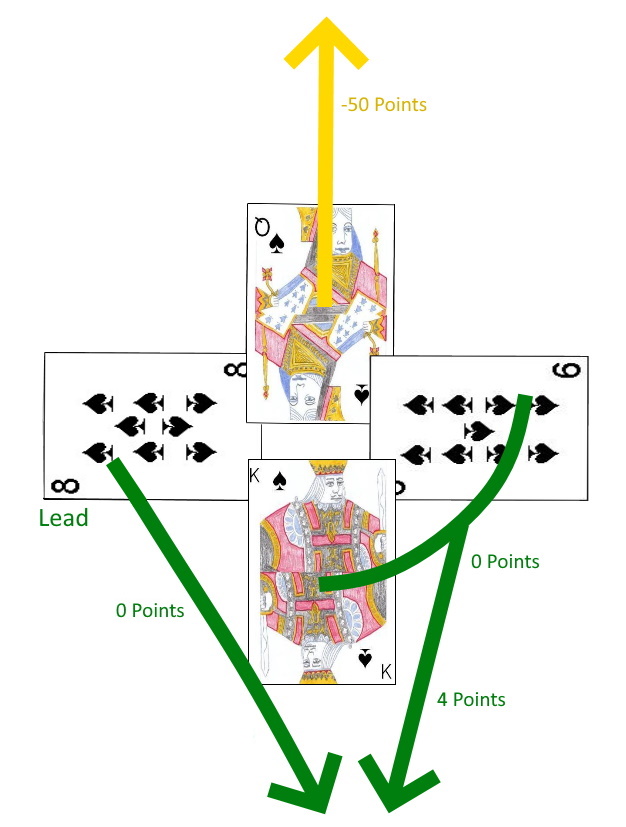
During play, the object is to earn the most total positive points over the course of a number of hands, so players will strive to win tricks containing point scoring cards. The following chart shows the value of each card in the deck, as captured in tricks during play:
| Card | Point Value as Captured in a Trick |
|---|
| Any Ace | 11 Points Each |
| Any Ten | 10 Points Each |
| Any King | 4 Points Each |
| Queen of Hearts, Diamonds, or Clubs | 3 Points Each |
| Any Jack | 2 Points Each |
| Any 7, 8, or 9 | 0 Points |
| Queen of Spades | -50 Points |
If a previous player has already played the Queen of Spades to the trick, if another player plays the Ace or King of Spades (and is legally able
to play that card based on the normal rules for playing a card to that trick), the player who played the Queen of Spades actually wins that card and must add it to the cards he managed to capture during the hand.
However, this rule only applies if the Queen of Spades was played before
that King or Ace to the same trick. The remainder of the cards
from that trick are still won by the player who plays the highest card of the suit originally played to the trick.
After all the tricks have been played and won at the end of the hand, the players
review the cards they had managed to win during the hand and add the total number of points won during that hand into an ongoing accumulated total (which, for a player taking the Queen of Spades during the hand, can be negative).
After a set number of hands (which should be an even multiple of four to ensure each player has been in the role of the dealer the same number of times), the game ends and the player with the highest number of accumulated points is declared the winner.
Copyright © 2015
CatsAtCards.com. All rights reserved.
 In Two-Ten-Jack, the suit of Hearts (♥) is always considered the permanent trump suit for the hand. In addition, the Ace of Spades (♠) is a special card (called the Speculation), which is considered the highest card in the deck. However, this card does have some specific rules on when it can be played
(see further below).
In Two-Ten-Jack, the suit of Hearts (♥) is always considered the permanent trump suit for the hand. In addition, the Ace of Spades (♠) is a special card (called the Speculation), which is considered the highest card in the deck. However, this card does have some specific rules on when it can be played
(see further below).


 Either one of the players comprising the opposing partnership containing the dealer may lead the first card to the first trick. These players may discuss this issue but must not, under any circumstances reveal any specifics of the cards in hand, but rather just make statements such as indicating that they prefer to lead to this first trick or not. Once it is decided amongst these players who will lead, that player then leads the first card to the first trick to start play.
Either one of the players comprising the opposing partnership containing the dealer may lead the first card to the first trick. These players may discuss this issue but must not, under any circumstances reveal any specifics of the cards in hand, but rather just make statements such as indicating that they prefer to lead to this first trick or not. Once it is decided amongst these players who will lead, that player then leads the first card to the first trick to start play.
 Both of the dealers for each hand would take approximately half of the deck and shuffle it thoroughly. One of the two dealers then begins dealing the cards, one-by-one and face-down into four distinct piles, formed in a square, in the middle of the table. He deals to these piles in a counter-clockwise direction, continuing until he runs out of cards in his stack. This first dealer then indicates the pile which should receive the next card and his partner then starts dealing from his own pile in the same way, starting with the pile indicated by his partner. He continues dealing also until his stack has also been exhausted. The last card dealt is called the Kirijimai. The pile containing this last card dealt is then taken by the player nearest to that pile who is one of the dealers on the current hand. After this player has taken his pile, the next player at his right takes the next pile
to the right of that the last pile and continuing to each subsequent
player in a counter-clockwise direction taking the next pile to the right of the last pile taken. Thus, each player will have taken one of the piles which becomes his hand.
Both of the dealers for each hand would take approximately half of the deck and shuffle it thoroughly. One of the two dealers then begins dealing the cards, one-by-one and face-down into four distinct piles, formed in a square, in the middle of the table. He deals to these piles in a counter-clockwise direction, continuing until he runs out of cards in his stack. This first dealer then indicates the pile which should receive the next card and his partner then starts dealing from his own pile in the same way, starting with the pile indicated by his partner. He continues dealing also until his stack has also been exhausted. The last card dealt is called the Kirijimai. The pile containing this last card dealt is then taken by the player nearest to that pile who is one of the dealers on the current hand. After this player has taken his pile, the next player at his right takes the next pile
to the right of that the last pile and continuing to each subsequent
player in a counter-clockwise direction taking the next pile to the right of the last pile taken. Thus, each player will have taken one of the piles which becomes his hand.
 If either partnership manages to capture 9 or more picture cards during the hand, that team is considered the winner of the hand. If both teams capture exactly 8 picture cards during the hand, the opponents of the team who had played the Rensho are considered the winners. The winning team earns a number of points (represented by tokens or stones) based on the following conditions:
If either partnership manages to capture 9 or more picture cards during the hand, that team is considered the winner of the hand. If both teams capture exactly 8 picture cards during the hand, the opponents of the team who had played the Rensho are considered the winners. The winning team earns a number of points (represented by tokens or stones) based on the following conditions:
 During play, the object is to earn the most total positive points over the course of a number of hands, so players will strive to win tricks containing point scoring cards. The following chart shows the value of each card in the deck, as captured in tricks during play:
During play, the object is to earn the most total positive points over the course of a number of hands, so players will strive to win tricks containing point scoring cards. The following chart shows the value of each card in the deck, as captured in tricks during play: